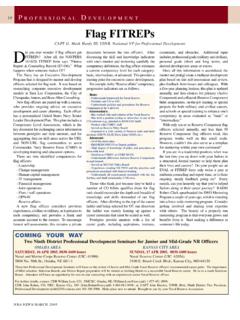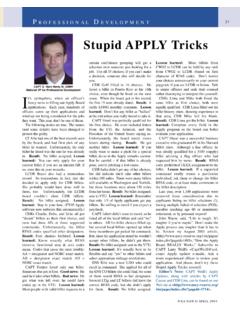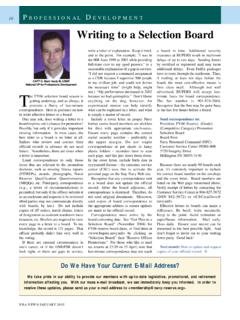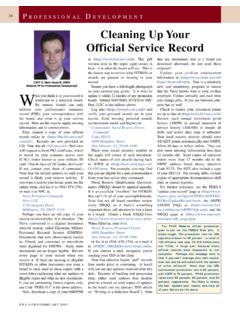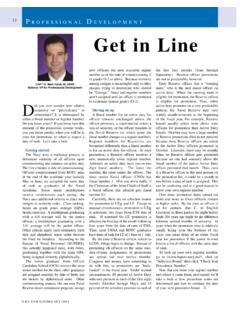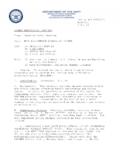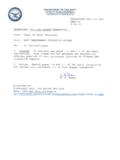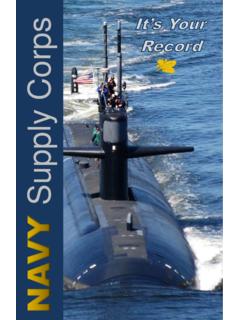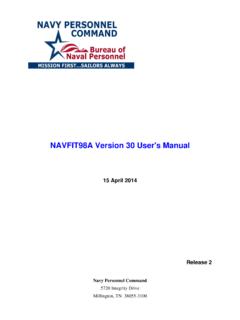Transcription of Managing Reporting Senior Averages - …
1 Ihave found no written guidance onmanaging Reporting Senior Averages . Asa result, I am consulted by commandingofficers that have painted themselves into acorner by setting their Averages too this error by planning for the reports (FITREPs) and evaluations(EVALs) may be the most importantdocument you sign as a commandingoff icer. The effects of a poorly written orgraded report may persist for decades,perhaps years after you have retired. Learnhow to manage your Averages now so youdon t leave a legacy of doomed your Reporting Senior cumulativeaverage (RSCA) by paygrade at < >.
2 This average updateson the first day of the month, 90 days afterreceipt of new reports. This providessuff icient correlation time for reports fromthe same marking period that arrive ondifferent dates. Consult your average beforewriting any EVAL or FITREP. Althoughblock 45 requires only summary groupaverage, provide your RSCA to your recommend sharing this information withyour unit when you take command. It helpsset expectations and diminishes anguish atreport you are a new CO, or are recentlypromoted, you have a clean start in at least onepaygrade.
3 A common error inexperiencedCOs make is setting their initial summarygroup average too high. The trait average ona Reporting Senior s first report is irrelevant(provided it is not below ). The first O-4report I signed was a for an officer whowas then selected above zone for write-up made the difference. My firstclass made chief with a EVAL in a peergroup with a trait average of you start at , you may find yourselfin extremis if selected to subsequentcommand. I have seen RSCAs above selection boards. That makes it tough foryour Sailors either they re or they retoast.
4 More importantly, there is no way todifferentiate superior recommend starting your average , and walking it up. An RSCA is frozen in time after 90 days; subsequentreports do not affect what is already , the second group average couldaverage , then , and so on. Eachsubsequent group fares slightly better thanthe historical norm. This creates the LakeWobegon effect, where all the children areabove average. This is not cheating; percentof line O-5 applicants received a commandbillet this year; 77 percent of line captainsreceived no pay billet.
5 You need everyadvantage to take care of your who have worked for me have adisproportionately high promotion andcommand selection rate. What s yourreputation? There are 13 non-adverse trait Averages ona FITREP, and 15 on an EVAL. I definenon-adverse as not below Using theFITREP as an example, we see that with atrait average of , there are three ways tobreak out negative performance, and nineways to break out positive is of much more value to a reportingsenior to be able to identify clearly the topperformers rather than the poor lose that ability with an inflated reports.
6 They usually are notcredible to a board, and may actually hurtrather than help the Sailor. If you manageyour RSCA correctly, you ll never need ve signed over 200 FITREPs and EVALs;my highest report to date is a Your topperformer should be at least two clicks above your average; that s sufficientdifferentiation to catch the attention of a t hesitate to use reports forretiring Sailors as ballast to help keep youraverage in check. BUPERSINST these reports to make the performancea matter of record. There is no prohibitionagainst positive comments in block 41 on there is evidence of misconduct or aSailor is being separated without beingrecommended for reaffiliation, don t hesitateto go well below This is dirtball ballast and can rapidly bring down a previouslyinflated RSCA to a manageable in mind the relative importance ofindividual trait scores.
7 Leadership is themost important. Leadership grades forCDRs and CAPTs other than 5 areoften considered down-ticks. ProfessionalExpertise and Mission Accomplishmentare a somewhat distant second. EqualOpportunity is a hygiene factor a 3 iscompletely that boards like to seeprog ression to the right. This means notonly moving from P to MP to EP, but also asteady increase in trait scores from the samereporting Senior (except upon a change inpaygrade.) Do not try to cheat the system bysplitting up a peer group to create multiple1-of-1 reports.
8 BUPERS is very adept atcatching these, and a 1-of-1 report is notvery useful anyway, since it doesn t showrelative performance. If you re in command,make the call, and rank all of your everyone follows these guidelines,any advantage will equalize. Meanwhile,manage your average, before it manages NEWS/october 2005 Professional Development Managing ReportingSenior AveragesCAPT G. Mark Hardy III, USNN ational VP for Professional DevelopmentEEffffeeccttiivvee 1155 JJuunnee 22000066,,ssuubbmmiitt rreeppoorrttssffoorr EE44 aanndd bbeellooww iinn tthhee ssaammee mmaannnneerr aassEE55 aanndd aabboovvee performance AvgGood performance Great performance Superior performanceI I IIII I I


